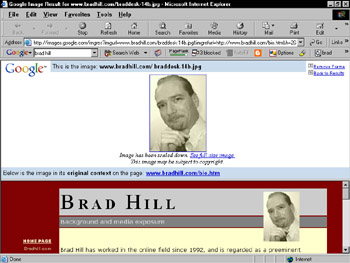A Picture Is Worth a Thousand Keywords
|
| < Day Day Up > |
|
Image searching in Google is less complex than Web searching and is fun in different ways. For example, you can search for pictures of people you haven’t seen in years, for postcard-like images of travel destinations, or for pictures of yourself.
Google’s task is a tricky one. It must match your keyword(s) with pictures — a far harder task than matching words with text. At best, Google can make educated guesses about the identity or subject matter of a picture based on the file name of the picture, the URL address of the image, the surrounding text, and any caption. So the results are bound to be erratic. Fortunately, Google errs on the side of abundance, delivering truckloads of possible photos and other images in response to your keywords.
Simple searches are identical to Web searches. From the Google home page, click the Images tab, enter a keyword or two, and press Enter. You can even use the site, intitle, allintitle, inurl, and allinurl operators described in the previous section when searching for images.
It’s in the search results that things differ from Web searches. Image results come in the form of thumbnails — small versions of images. Click any thumbnail to see a larger version of the image, along with the Web page on which it resides. As you see in Figure 2-11, Google reproduces the image above the Web page containing the image — arguably a big waste of space. (Click the Remove Frame link to get rid of it.) This second reproduction of the image is usually a thumbnail, too, albeit a somewhat larger one. You may click on this thumbnail to see a full-size version of the picture. Or you can scroll down the page to see the picture in context.

Figure 2-11: Google’s display of a search image and its Web page.
|
| < Day Day Up > |
|
EAN: 2147483647
Pages: 188